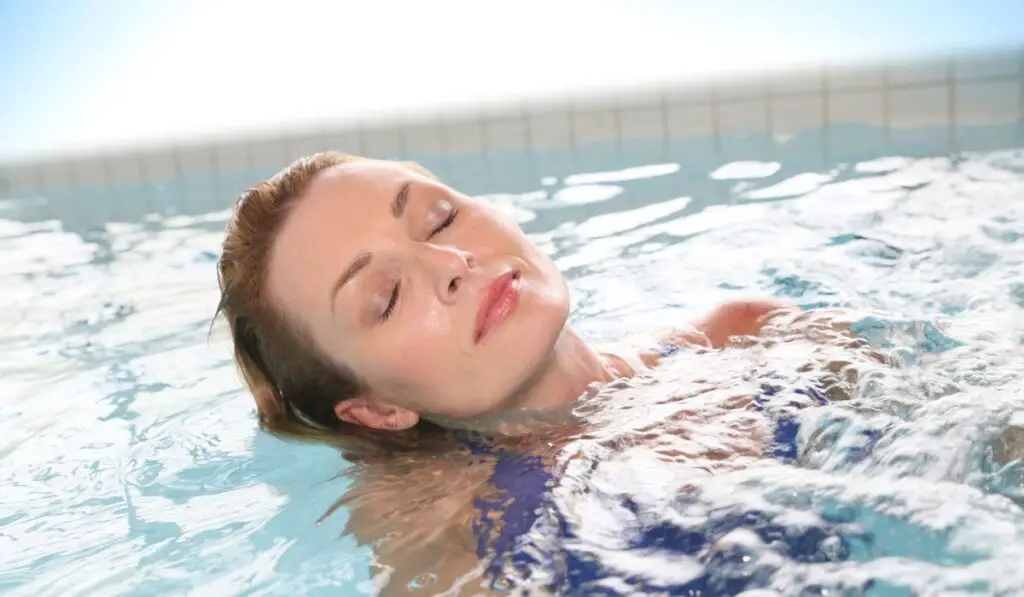Let’s be honest… hot tubs are amazing! Whether you need a therapeutic soak after a long day or a fun place to socialize with friends, hot tubs are always a great idea. But the reality is that too much of a good thing can have some negative side effects. So how long can you safely stay in a hot tub?
You should limit your hot tub soak to no more than 30 minutes at a time. Make it even shorter if you’re soaking in especially high temperatures. This is because extended exposure to hot water can lead to dehydration and potentially raise your body temperature to unsafe levels.
When you’re in a hot tub, your body has to work harder to regulate your temperature. Even a slight increase in body temperature can cause dehydration, leading to headaches, dizziness, and nausea. So it’s important to consider safety limits when enjoying a hot tub. Let’s look at the signs of dehydration and overheating in hot tubs as well as the preventive measures to stay safe while enjoying a soak.
How Long Is It Safe to Be in a Hot Tub?

According to the Mayo Clinic, the answer is probably not as long as you would like it to be. They recommend limiting yourself to 15 minutes at a time. However, the general consensus is that 30 minutes is the maximum you should spend in a hot tub.
Now, this may not seem like a lot, but it’s actually the perfect amount of time to enjoy all the benefits of a hot tub — and if you want more, you can always hop back in for another round a bit later.
Of course, this advice is for healthy adults. If you have any underlying health conditions, are pregnant, or are taking any medications that might make you more susceptible to heat-related illness, the duration of your hot tub soak should be even shorter.
Additionally, the water temperature also influences how long you can safely stay in a hot tub. The higher the water temperature, the shorter the soak should be. So if you like it hot, make sure to take more breaks and drink plenty of fluids to stay hydrated.
Who Should Take More Precautions?
Hot tubs are safe for most people, but there are some groups of people who should take more precautions.
Pregnant Women
Soaking in a hot water tub can ease muscle aches and pain related to pregnancy, but it can also raise the body temperature, which may not be ideal for the unborn child. It’s best to avoid hot tubs altogether during the first trimester, and after that, limit yourself to brief 10-15 minute soaking sessions. And never increase the temperature over 101˚F (38.3˚C).
The Elderly
Older adults are also more susceptible to the effects of heat, so they should set the temperature lower (around 104˚F or 40˚C) and limit themselves to 15-20 minute soaking sessions. However, if elderly people have no health conditions that put them at risk, they can safely enjoy hot tubs like anyone else.
Children
Hot tubs aren’t particularly safe for kids because their bodies heat up very quickly. It’s best to avoid hot tubs altogether for children under five. For older kids, limit their exposure to 10-15 minutes and ensure the temperature is set below 100˚F (37.7˚C).
Make sure kids don’t immerse themselves completely and take breaks to cool down between soakings.
People With Certain Medical Conditions
People with kidney disease need to be particularly careful when soaking in a hot tub because of the risk of dehydration. They should limit their exposure to 10-15 minutes at a time and drink plenty of fluids before and after the soak.
Hot tubs also aren’t ideal for people with diabetes, low blood pressure, or heart disease. The combination of heat and water can put stress on the body and make it difficult to regulate blood sugar levels or blood pressure. If you have any of these conditions, talk to your doctor before using hot tubs.
Lastly, anyone taking medication that can cause drowsiness or dizziness should avoid hot tubs.
What’s the Maximum Temperature a Hot Tub Should Be?
Hot tubs max out at around 104˚F (40˚C). Even this much heat becomes uncomfortable for most people, so it’s recommended to cut back the time if the temperature is turned up this high.
The ideal temperature for a hot tub is between 100 and 102˚F (37.7-39˚C). This is hot enough to provide some health benefits but not so hot that it becomes dangerous.
Signs You Need to Take a Break From the Tub
Usually, your body will give you some pretty clear signs when it’s time to take a break from the tub. Let’s discuss why these signs occur and how you can spot them.
- Dehydration: Hot tubs are hot, so your body precipitates a lot of sweat. The longer you stay in, the more water you lose and the higher the chance of dehydration. The most common sign of dehydration is feeling thirsty.
Other signs include tiredness, headache, dry mouth and lips, and dark-colored urine. If ignored, dehydration can lead to more serious problems like heat exhaustion or worse if you have an underlying medical condition.
- Dizziness: If you feel light-headed or unsteady when you stand up, it’s a sign that your body isn’t handling the heat well. The best thing to do is get out of the tub and drink water. However, if you remain dizzy after sitting or lying down for a few minutes, call 911, as you may be suffering from heatstroke.
- Nausea/Vomiting: Nausea is a common sign of heat exhaustion and usually goes hand in hand with dizziness. Generally, people who enter the tub with a full stomach are more prone to experience nausea. It’s best to wait at least an hour after eating before hot tubbing. If you start feeling nauseous while in the tub, get out immediately.
- Headache: If you have a headache, it’s probably due to dehydration, which we discussed above.
- Racing Heartbeat: If your heart is pounding faster than normal, it could be a sign of overheating. If it happens, take an immediate brake before the symptoms worsen. In severe cases, a racing heart is accompanied by tingling in the extremities, shortness of breath, or headache.
If a situation like this happens, call for medical help. Overheating can be easily avoided by ensuring the temperature is not too high.
- Skin Problems: If you have sensitive skin, you may experience redness, itchiness, or rashes. This is usually due to the chemicals in the water or the heat itself. If you have skin problems, never raise the temperature too high and take breaks often to allow your skin to cool down.
- Hypotension/Low Blood Pressure: Older adults and those with heart conditions are especially susceptible to dipping blood pressure. The symptoms include feeling faint, blurred vision, nausea, and difficulty in concentration. It can be dangerous if not monitored, so either avoid long exposure to the tub or check your BP regularly.
Tips for Staying Safe in a Hot Tub

Following just a few simple tips can help you enjoy your hot tub experience while staying safe. Here’s a recap:
- Don’t stay in the tub for more than 30 minutes at a time. If you’re a healthy adult, you may be able to stay in for a bit longer, but for most people, 30 minutes is the max.
- Keep the temperature below 104˚F (40˚C). The closer it is to 104˚, the shorter your exposure should be.
- Avoid hot tubs if you’re pregnant or have a medical condition. If you have any doubts, check with your doctor first.
- Kids should be supervised at all times. Make sure they stay on a raised seat and aren’t in the water for more than 10 minutes at a time.
- Don’t drink alcohol before or during your hot tub session. Alcohol and hot tubs are a dangerous combination. Not only does alcohol increase the risk of dehydration, but it can also make you more likely to feel dizzy or faint.
- Avoid eating a big meal before hot tubbing. Soaking on a full stomach can induce nausea.
- Drink plenty of fluids to stay hydrated. A cold drink after your session is a good idea.
- Listen to your body, and don’t push yourself too hard. If something doesn’t feel right, get out of the tub. Take a break and see how you feel after a few minutes.
